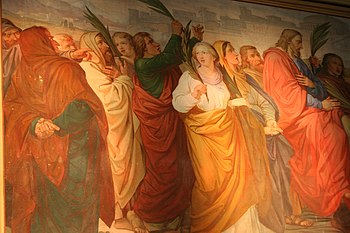
Pentecost (Photo credit: Lawrence OP)
Pentecost (Ancient Greek: Πεντηκοστή [ἡμέρα], Pentēkostē [hēmera], “the fiftieth [day]”) is the Greek name for the Feast of Weeks, a prominent feast in the calendar of ancient Israel celebrating the giving of the Law on Sinai.
This feast is still celebrated in Judaism as Shavuot.
Later, in the Christian liturgical year, it became a feast commemorating the descent of the Holy Spirit upon the Apostles and other followers of Jesus Christ (120 in all), as described in the Acts of the Apostles 2:1–31.
For this reason, Pentecost is sometimes described by some Christians today as the “Birthday of the Church“.
In the Eastern church, Pentecost can also refer to the whole fifty days between Easter and Pentecost, hence the book containing the liturgical texts for Paschaltide is called the Pentecostarion.
The feast is also called White Sunday, or Whitsunday, especially in England, where the following Monday was traditionally a public holiday.
The Talmud refers to Shavuot as Atzeret (Hebrew: עצרת, literally, “refraining” or “holding back”), referring to the prohibition against work on this holiday and to the conclusion of the holiday and season of Passover.
Since Shavuot occurs 50 days after Passover, Hellenistic Jews gave it the name Pentecost.(πεντηκοστή, “fiftieth day”).
According to Jewish tradition, Pentecost commemorates God giving the Ten Commandments at Mount Sinai fifty days after the Exodus.
Present were about one hundred and twenty followers of Christ (Acts 1:15), including the Twelve Apostles (i.e. the Eleven faithful disciples and Matthias who was Judas’ replacement) (Acts 1:13, 26), his mother Mary, various other women disciples and his brothers (Acts 1:14).
Their reception of Baptism in the Holy Spirit in the Upper Room is recounted in Acts 2:1–6. While those on whom the Spirit had descended were speaking in many languages, the Apostle Peter stood up with the eleven and proclaimed to the crowd that this event was the fulfillment of the prophecy (“I will pour out my spirit”).
According to the current Jewish Calendar, the date of Pentecost is fifty days from Passover.
Since the date of Easter is calculated differently in the East and West (see Easter controversy), in most years the two traditions celebrate Pentecost on different days (though in some years the celebrations will coincide, as in 2010, 2011, and 2014).
In the Eastern Orthodox Church, Pentecost is one of the Orthodox Great Feasts and is considered to be the highest ranking Great Feast of the Lord, second in rank only to Easter/Resurrection Sunday/Passover.
Theologically, Orthodox do not consider Pentecost to be the “birthday” of the Church; they see the Church as having existed before the creation of the world.
They may depict symbols of the Holy Spirit, such as the dove or flames, symbols of the church such as Noah’s Ark and the Pomegranate, or especially within Protestant churches of Reformed and Evangelical traditions, words rather than images naming for example, the gifts and Fruits of the Spirit.
While this practice is common among a wide spectrum of Western denominations (Eastern Churches do not employ instrumental accompaniment in their worship) it is particularly typical, and distinctive to the heritage of the Moravian Church.
The Pentecost Novena is considered the first Novena, all other Novenas offered in preparation of various festivals and Saints days deriving their practice from those original nine days of prayer observed by the disciples of Christ.
The holiday was also one of the three days each year (along with Christmas and Easter) Roman Catholics were required to confess and receive the sacrament of Holy Communion in order to remain in good church standing.





